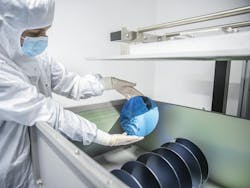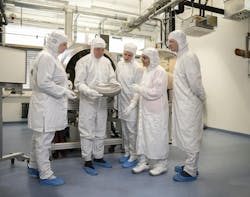High-precision optics are essential for commercial laser-driven fusion
Beyond laser technology advances, the path to putting commercial laser-driven fusion energy on the grid by the 2040s or 2050s requires high-precision optics that can meet stringent optical, mechanical, and thermal specifications to withstand extreme conditions.
Laser-driven fusion technology is currently being fast-tracked to put carbon-free energy on the power grids—and hopefully help save the planet. Commercial fusion power plant designs are still evolving, but scientists and engineers in Germany envision one within the 2035+ timeframe that features approximately 400 beamlines (see video).
While the design continues to evolve, a commercial laser-driven fusion power plant featuring ~400 beamlines will require ~7,000 optical components, including ~3,200 reflective mirror optics meticulously engineered to optimize the efficiency and effectiveness of fusion experiments.
These reflective mirrors “must meet stringent optical, mechanical, and thermal specifications to withstand the extreme conditions within a laser fusion power plant—requirements that haven’t been fully achieved in combination yet,” says Nadja Felde, scientific coordinator and deputy head of the Functional Surfaces and Coatings Department at Fraunhofer Institute of Applied Optics and Precision Engineering IOF in Jena, Germany.
Fraunhofer IOF’s pursuit of high-precision optics for laser-driven fusion stems from decades of dedicated research and pioneering optics and photonics innovations. “We’ve developed a robust process chain during the past 25 years that enables us to design and manufacture high-quality optical components ranging from 500 millimeters to large-scale meter optics—covering both flat and freeform geometries,” Felde says.
Developing exceptional optical components “is crucial to advance laser-driven fusion technologies that promise to revolutionize our energy landscape,” Felde explains.
SHARP consortium takes on high-precision optics challenges for fusion
Germany’s Scalable High-power Reflectors for Petawatts (SHARP) consortium was awarded 9.2M euros ($10.4M) in fusion funding through the program “Fusion 2040: Research on the Way to the Fusion Power Plant” by the German Federal Ministry of Education and Research, and work is underway by SCHOTT AG, LAYERTEC GmbH, asphericon GmbH, 3D-Micromac AG, optiX fab GmbH, Cutting Edge Coatings GmbH, robeko GmbH & Co. KG, Laser Zentrum Hannover e.V., Fraunhofer IOF, and Fraunhofer IMWS to explore: Controlling the thermal properties of large-area mirrors to maintain high performance; developing manufacturing technologies for super-polished, curved, large-area optics; implementing zero-defect cleaning strategies and substrate optimization; thermal stabilization and active cooling; and creating optical coatings with innovative heat management solutions.
“It’s truly remarkable to be part of such an outstanding consortium that unites Germany’s key stakeholders in both science and industry within the field of the optical process chain,” says Felde. “One of the most exciting aspects is contributing to the initial steps toward commercial laser-driven fusion power plants. The feeling of being on the forefront of a transformative field is exhilarating and motivates me and my colleagues at Fraunhofer IOF to push the boundaries of what’s possible in laser-driven fusion technology.”
As part of SHARP’s overarching goal, “Fraunhofer IOF is developing the scientific and technical foundations of substrate manufacturing techniques for high-performance mirrors, silicate and plasma-activated bonding techniques for substrate cooling, novel coatings, and characterization methods for thermally stable and laser-resistant reflectors,” Felde says.
On the substrate side, “combinatorial grinding and polishing processes are being developed to create a new generation of super-polished surfaces,” Felde explains. “We’re working on methods to eliminate imperfections within the substrate surface zone, as well as cleaning and handling strategies for large-area substrates—with a goal of zero defects. And we’re exploring various substrate materials, such as fused silica, ultralow expansion (ULE) glass, Borofloat 33 (borosilicate glass), and Zerodur (glass/ceramic material), with different thermal expansion coefficients suitable for laser fusion.”
The consortium’s primary focus is thermal stabilization and active conditioning by substrate-side cooling of the overall system. “We’re developing new approaches to create thermally stable and thermally optimized layer designs with sufficiently low trace-element content,” Felde says. “Coatings systems designed with increased thermal conductivity may reduce the thermal barrier typically associated with conventional dielectric mirror coatings, so we’re also exploring quantized nanolaminates, metal-enhanced reflectors, and the use of materials such as optically transparent diamond-like carbon (DLC).”
Beyond laser-driven fusion, advances targeted by the SHARP consortium should have potential for other future markets such as high-power laser applications and laser materials processing. “Knowledge gained from this project may also be useful for space communications—and especially for the next generation of substrates and coatings for extreme ultraviolet (EUV) lithography,” says Felde.
Thermal stability within extreme conditions
Laser-driven fusion involves extreme heat and all of the optical components must be able to endure it. Laser mirrors across 400 beamlines, for example, must withstand extreme loads for extended periods. “Parameters for laser-driven fusion reactors’ high laser pulse energies, with very high average power, can reach up to 100 megawatts (MW)—which translates to as much as 1-MW per optical component,” says Felde.
Even with low absorption and poor thermal conductivity, “significant temperature increases can occur and cause wavefront deformations, cracks, and ablation effects,” Felde points out. “Numerous reflectors along each beamline can also exacerbate thermally induced deformations. Previous laser optics efforts focused primarily on the laser-induced damage threshold, but future considerations will hinge on thermal absorption during continuous operation.”
It makes developing thermally conductive and highly reflective components crucial for laser fusion power plants. This requires a thorough understanding of the thermal properties related to materials, coating technologies, structures, and designs of the project’s various approaches.
“For substrate cooling, laser internal processing will use flow-supported laser ablation (FSLA) as well as glass joining via bonding methods without interlayers such as silicate bonding and plasma-activated bonding,” Felde says. “In terms of coatings, we’ll explore metamaterials such as nanolaminates and heterostructures, using different deposition technologies—ion beam sputtering/IBS, magnetron sputtering, atomic layer deposition (ALD). Beyond this, development and testing of metal-hybrid mirrors will target enhancing thermal conductivity.”
The service life projected for 1 gigashot equates to about three years at a repetition rate of 10 Hz—and the economic efficiency and ecological balance of future laser-driven fusion power plants hinge on the scalability of processes. “This includes the size of the optics suitable for a ~12-inch high-power laser beam and all of the optical components that will need to be replaced or regenerated after laser damage,” Felde adds. “Production suitability is defined by a yield of 95%, maximum production efficiency, and minimized costs.”
Manufacturing large-area optics
Manufacturing large-area optics is yet another ongoing challenge and achieving the necessary high quality at low costs is a significant hurdle. “It’s crucial to develop efficient process chains that enable reliable production of a large number of components,” says Felde. “Ensuring consistency and precision across all manufactured optics is essential to meet the stringent requirements of laser fusion applications.”
It requires addressing thermal stability, surface quality, and optical performance issues. “Fostering collaboration between different stakeholders within the supply chain is vital for sharing knowledge, optimizing processes, and driving innovation,” Felde adds. “By overcoming these challenges, we can pave the way for scalable and economically viable laser fusion technology solutions.”
Race against the clock
While the primary application of the consortium’s work is for laser fusion, the technologies required for a laser-driven fusion power plant are not remotely close to being fully developed.
“It will take time before a functional and economical fusion power plant can supply electricity to our grids,” says Felde. “The R&D phase to create necessary technological approaches and components for a laser-driven fusion power plant is expected to continue until the first half of the 2030s—including our SHARP project. We expect the transfer phase to begin by 2040, and the first operational power plants are expected during the same timeframe.”
Beyond the overall system use of laser fusion within the beamline segment, secondary applications for the foundational technologies are being developed for high-power laser applications, laser material processing, and next-gen substrates and coatings for EUV lithography.
Thermally induced effects within optical components are a limiting factor for many industrial applications. “For next-gen laser communications terminals, effective temperature management must be considered—due to increased continuous-wave (CW) laser power—to avoid wavefront errors,” says Felde. “In disk lasers, reflectors can lead to rising temperatures, which become problematic at higher pump power levels.”
High-reflectivity components in laser materials processing are also subjected to significant thermal loads. In EUV lithography applications, even low absorption levels or thermal gradients can cause considerable imaging errors. The team is actively developing alternatives to address these challenges.
Now that SHARP is officially underway, Felde and colleagues are delving into the initial phases of technology development, which “involves rigorous testing and validation of concepts before gradually scaling up to large-area optics,” she says.
MEET THE RESEARCHERS
During the LASER World of PHOTONICS trade fair in Munich, Germany, June 24-27, 2025, you can find the Fraunhofer IOF team at booth 415 in Hall A2.
FURTHER READING
Department of Functional Surfaces and Coatings at Fraunhofer IOF: www.iof.fraunhofer.de/en/competences/coating-and-surface-functionalization.html
Department of Precision Optical Components and Systems at Fraunhofer IOF: www.iof.fraunhofer.de/en/competences/diamond-based-ultra-precision-processing.html
About the Author
Sally Cole Johnson
Editor in Chief
Sally Cole Johnson, Laser Focus World’s editor in chief, is a science and technology journalist who specializes in physics and semiconductors.


